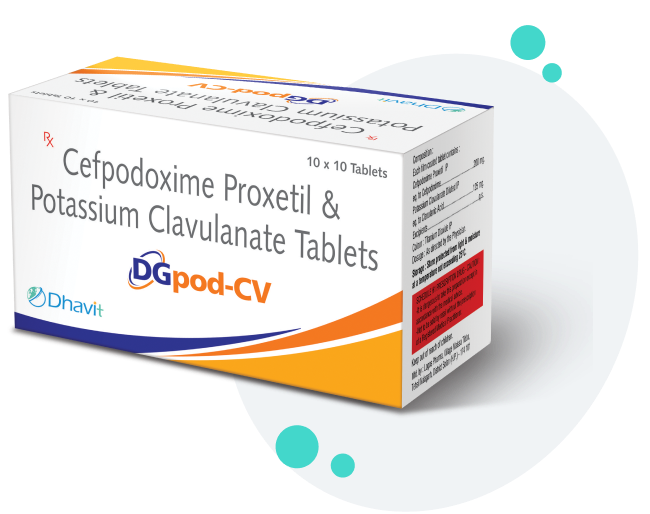
DGpod-CV Tablets
DGpod-CV Tablets (Cefpodoxime proxetil + Clavulanate potassium)
Composition
Each film-coated tablet contains
- Cefpodoxime Proxetil
- Clavulanate Potassium diluted
Composition
Cefpodoxime Proxetil
equivalent to Cefpodoxime: 200 mg
Clavulanate Potassium diluted
equivalent to Clavulanic Acid: 125 mg
Pharmacodynamics
DGpod-CV tablets are a fixed-dose combination of cefpodoxime proxetil and potassium clavulanate. Cefpodoxime proxetil is an orally administered, extended-spectrum, semi-synthetic antibiotic of the cephalosporin class.
Clavulanic acid is produced by the fermentation of Streptomyces clavuligerus. It is a beta-lactam structurally related to the penicillins and possesses the ability to inactivate a wide variety of beta-lactamases by blocking the active sites of these enzymes. Clavulanic acid is particularly active against the clinically important plasmid-mediated beta-lactamases frequently responsible for transferred drug resistance to penicillins and cephalosporins.
Microbiology
The bactericidal action of cefpodoxime results from inhibition of cell wall synthesis. Cefpodoxime is active against a wide-spectrum of Gram-positive and Gram-negative bacteria. Cefpodoxime has shown to be active against most strains of the following microorganisms, both in vitro and in clinical infections.
Antibacterial Spectrum
Commonly Susceptible Species
Aerobic Gram-positive microorganisms:
- Staphylococcus aureus (including penicillinase-producing strains)
- Staphylococcus saprophyticus
- Streptococcus pneumoniae (excluding penicillin-resistant strains)
- Streptococcus pyogenes
Aerobic Gram-negative microorganisms:
- Haemophilus influenza (including beta-lactamase producing strains)
- Moraxella (Branhamella) catarrhalis
- Escherichia coli
- Klebsiella pneumoniae
- Proteus mirabilis
- Neisseria gonorrhoeae (including penicillinase-producing strains)
Aerobic Gram-positive microorganisms:
- Streptococcus agalactiae
- Streptococcus spp. (Groups C, G, F)
Aerobic Gram-negative microorganisms:
- Citrobacter divercus
- Klebsiella oxytoca
- Proteus vulgaris
- Providencia rettgeri
- Haemophilus parainfluenzae
Anaerobic Gram-positive microorganisms:
- Peptostreptococcus magnus
Pharmacokinetics
Cefpodoxime proxetil
Cefpodoxime proxetil is a prodrug that is absorbed from the gastrointestinal tract and de-esterified to its active metabolite, cefpodoxime.
Absorption: Bioavailability of cefpodoxime is 50% in fasting subjects and it increases in presence of food.
Distribution: Well distributed after oral administration. Cefpodoxime reaches therapeutic concentrations in respiratory tract and genito-urinary tracts and bile. Protein binding of cefpodoxime ranges from 20 to 30%. The plasma half-life of cefpodoxime is about 2 to 3 hours and is prolonged in patients with impaired renal function.
Excretion: Cefpodoxime is excreted unchanged in urine.
Clavulanate Potassium
Absorption: Well absorbed after oral administration
Distribution: Well distributed after oral administration. Protein binding of clavulanic acid is about 30%. The plasma half-life of clavulanic acid is one hour.
Excretion: About 60% of clavulanic acid is excreted unchanged in urine. The clavulanic acid component protects cefpodoxime from degradation by beta-lactamase enzymes and effectively extends the antibiotic spectrum of cefpodoxime to include many bacteria normally resistant to cefpodoxime and other beta-lactam antibiotics. Thus, possesses the distinctive properties of a broad-spectrum antibiotic and a beta-lactamase inhibitor.
Indications
DGpod-CV tablets are indicated for the treatment of patients with mild-to-moderate infections caused by susceptible strains of the designated microorganisms in the conditions listed below:
- Acute otitis media caused by Streptococcus pneumoniae (excluding penicillin-resistant strains), Streptococcus pyogenes, Haemophilus influenzae (including beta-lactamase-producing strains), or Moraxella (Branhamella) catarrhalis (including beta-lactamase-producing strains).
- Pharyngitis and/or tonsillitis caused by Streptococcus pyogenes.
Cefpodoxime proxetil is generally effective in the eradication of streptococci from the oropharynx. However, data establishing the efficacy of cefpodoxime proxetil for the prophylaxis of subsequent rheumatic fever are not available.
- Community-acquired pneumonia caused by Streptococcus pneumoniae or Haemophilus influenzae (including beta-lactamase-producing strains).
- Acute bacterial exacerbation of chronic bronchitis caused by Streptococcus pneumoniae, Haemophilus influenzae (non-beta-lactamase-producing strains only), or Moraxella catarrhalis.
- Acute, uncomplicated urethral and cervical gonorrhea caused by Neisseria gonorrhoeae (including penicillinase-producing strains).
- Acute, uncomplicated ano-rectal infections in women due to Neisseria gonorrhoeae (including penicillinase-producing strains).
- Uncomplicated skin and skin structure infections caused by Staphylococcus aureus (including penicillinase-producing strains) or Streptococcus pyogenes. Abscesses should be surgically drained as clinically indicated.
- Acute maxillary sinusitis caused by Haemophilus influenzae (including beta-lactamase-producing strains), Streptococcus pneumoniae and Moraxella catarrhalis.
- Uncomplicated urinary tract infections (cystitis) caused by Escherichia coli, Klebsiella pneumoniae, Proteus mirabilis or Staphylococcus saprophyticus.
Dosage and Administration
DGpod-CV Tablets should be swallowed whole without chewing
The recommended dosages, duration of treatment and applicable patient population are as described in the following table:
Adults and Adolescents (aged 12 years and older)
| Type of infection | Total daily dose | Dose frequency | Duration |
|---|---|---|---|
| Pharyngitis and/or tonsillitis | 200 mg | 100 mg q12 hours | 5–10 days |
| Acute community-acquired pneumonia | 400 mg | 200 mg q12 hours | 14 days |
| Acute bacterial exacerbations of chronic bronchitis | 400 mg | 200 mg q12 hours | 10 days |
| Uncomplicated gonorrhoea (men and women) and rectal gonococcal infections (women) | 200 mg | Single dose | |
| Skin and skin structure | 800 mg | 400 mg q12 hours | 7–14 days |
| Acute maxillary sinusitis | 400 mg | 200 mg q12 hours | 10 days |
| Uncomplicated urinary tract infection | 200 mg | 100 mg q12 hours | 7 days |
*Dose of DGpod-CV Tablets is based on the cefpodoxime component.
Contraindications
Is contraindicated in patients with a known allergy to cephalosporin group of antibiotics.
Drug interactions
Antacids
Concomitant administration of high doses of antacids (sodium bicarbonate and aluminum hydroxide) or H2-blockers reduces peak plasma levels by 24–42% and the extent of absorption by 27–32%, respectively. The rate of absorption is not altered by these concomitant medications. Oral anti-cholinergics (e.g., propantheline) delay peak plasma levels (47% increase in the Tmax), but do not affect the extent of absorption (AUC).
Probenecid
As with other beta-lactam antibiotics, renal excretion of cefpodoxime was inhibited by probenecid and resulted in an approximately 31% increase in the AUC and a 20% increase in peak cefpodoxime plasma levels.
Food
The bioavailability increases if DGpod-CV tablets are taken during meals.
Storage and Handling Instructions
Store in a cool, dry place. Protect from light.
Keep out of the reach of children.
Packaging Information
DGpod-CV Tablets – Strip pack of 10 tablets
Got a question?
We’d love to talk about how we can help you.